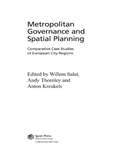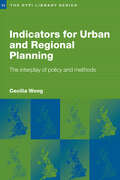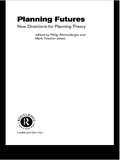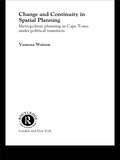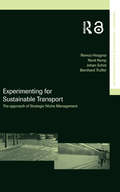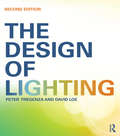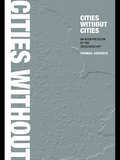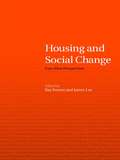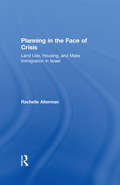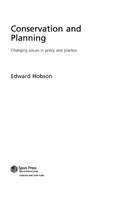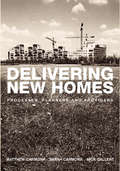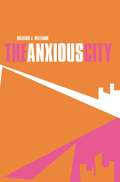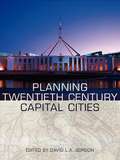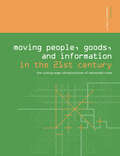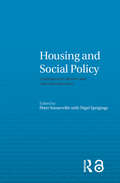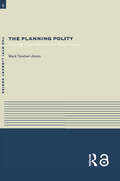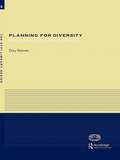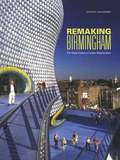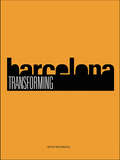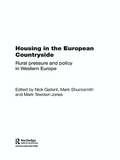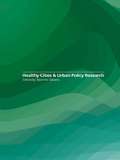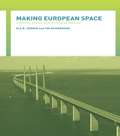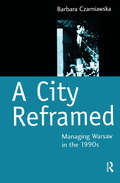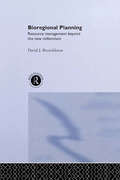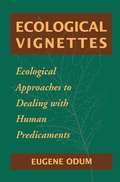- Table View
- List View
Metropolitan Governance and Spatial Planning: Comparative Case Studies of European City-Regions
by Willem Salet Andy Thornley Anton KreukelsMetropolitan Governance and Spatial Planning explores the relationship between metropolitan decision-making and strategies to co-ordinate spatial policy. This relationship is examined across 20 cities of Europe and the similarities and differences analysed.Cities are having to formulate their urban policies in a very complex and turbulent environment. They are faced with numerous new pressures and problems and these often create contradictory conditions. The book provides a theoretical framework for exploring these issues and links this to a detailed investigation of each city. In the context of globalisation, cities in the last twenty years have experienced new patterns of activity and these usually transcend political boundaries. The management of these changes therefore requires an effort of co-ordination and different cities have found different approaches.However the institutional setting itself has not remained static. The nation states in Europe have handed over many responsibilities to the European Union while also increasing devolution to regions and cities. Government has therefore become a more complex multi-level activity.There has also been the move from government to governance. Many different public, quasi-public and private bodies are now involved in making decisions that affect urban development. Metropolitan governance is therefore also a complex multi-actor process.In these conditions of fragmented governance and the widening spatial networking of urban development, the issue of policy co-ordination become ever more important. The exploration of the 20 cities shows that many face similar difficulties while some also provide interesting examples of innovative practice. The book concludes that the way forward is to find strategies to link the different spheres of metropolitan action through 'organising connectivity'.
Indicators for Urban and Regional Planning: The Interplay of Policy and Methods (RTPI Library Series)
by Cecilia WongThis book focuses on the measurement and utilisation of quantitative indicators in the urban and regional planning fields. There has been a resurgence of academic and policy interest in using indicators to inform planning, partly in response to the current government's information intensive approach to decision-making. The content of the book falls into three broad sections: indicators usage and policy-making; methodological and conception issues; and case studies of policy indicators.
Planning Futures: New Directions for Planning Theory
by Philip Allmendinger Mark Tewdwr-JonePlanning theory is currently in a confused state as a consequence of a number of changes over the last ten years in planning practice and social and economic theory. Even prior to these events, planning theory was an uncertain discipline, reflecting planning's precarious position between and resting upon a range of professional subject areas and philosophical roots. Planning Futures is an attempt to pin down the constantly evolving landscape of planning theory and to chart a path through this fast changing field.Planning Futures is an up-to-date reader on planning theory, but adds something more to the subject area than a mere textbook. The contributors have attempted to bridge theory and practice while putting forward new theoretical ideas. By drawing upon examples from planning practice and case study scenarios, the authors ensure that the work discusses planning theory within the context of present planning practice. Case studies are drawn from an international arena, from the UK, Europe, South Africa and Australia.
Change and Continuity in Spatial Planning: Metropolitan Planning in Cape Town Under Political Transition (Cities And Regions Ser.)
by Vanessa WatsonChange and Continuity in Spatial Planning addresses a question of enduring interest to planners: can planning really bring about significant and positive change? In South Africa the process of political transition appeared to create the preconditions for planners to demonstrate how their traditional humanitarian and environmental concerns could find concrete expression in the reshaping of the built environment.Integral to this story is how planning practices have been shaped by the past, in a rapidly changing context characterised by a globalising economy, new systems of governance, a changing political ideology, and a culture of intensifying poverty and diversity. More broadly, the book addresses the issue of how planners use power, in situations which themselves represent networks of power relations, where both planners and those they engage with operate through frames of reference fundamentally shaped by place and history.
Experimenting for Sustainable Transport: The Approach of Strategic Niche Management (Transport, Development and Sustainability Series)
by Johan Schot Remco Hoogma Rene Kemp Bernhard TrufferTechnological change is a central feature of modern societies and a powerful source for social change. There is an urgent task to direct these new technologies towards sustainability, but society lacks perspectives, instruments and policies to accomplish this. There is no blueprint for a sustainable future, and it is necessary to experiment with alternative paths that seem promising. Various new transport technologies promise to bring sustainability benefits. But as this book shows, important lessons are often overlooked because the experiments are not designed to challenge the basic assumptions about established patterns of transport choices. Learning how to organise the process of innovation implementation is essential if the maximum impact is to be achieved - it is here that strategic niche management offers new perspectives. The book uses a series of eight recent experiments with electric vehicles, carsharing schemes, bicycle pools and fleet management to illustrate the means by which technological change must be closely linked to social change if successful implementation is to take place. The basic divide between proponents of technological fixes and those in favour of behavioural change needs to be bridged, perhaps indicating a third way.
The Design of Lighting
by Peter Tregenza David LoeThis fully updated edition of the successful book The Design of Lighting, provides the lighting knowledge needed by the architect in practice, the interior designer and students of both disciplines. The new edition offers a clear structure, carefully selected material and linking of lighting with other subjects, in order to provide the reader with a comprehensive and specifically architectural approach to lighting. Features of this new edition include: technical knowledge of lighting in the context of architectural design; an emphasis on imagination in architectural light and presentation of the tools necessary in practice for creative design; additional chapters on the behaviour of light and on the context of design; a strong emphasis on sustainable design and energy saving, with data and examples; analyses of actual lighting schemes and references to current standards and design guides; an up-to-date review of lamp and lighting technology, with recommendations on the choice of equipment; a revision of the calculation section, with examples and step-by-step instructions, based on recent student feedback about the book.
Cities Without Cities: An Interpretation of the Zwischenstadt
by Thomas SievertsThis book investigates the characteristics of today's built environment: no longer simply a city but increasingly large conurbations made up of a number of development clusters, linked by transport routes. The diffusion of the once compact city into a city web, the 'meta city' is mirrored by changes in society from communities with strong social cohesion and interest in their towns and cities to individuals pursing their own goals, with global social links and little interest in their city.
Housing and Social Change: East-West Perspectives (Housing and Society Series)
by Ray Forrest James LeeThis wide-ranging exploration of the key contemporary relationships between social change and housing is both policy-oriented and theoretical, drawing on a group of internationally-respected academics. It is also multidisciplinary, incorporating sociology, economics, social policy and human geography perspective. Its international perspective is rooted in its examination of issues such as economic insecurity and instability, social diversity, financial and social exclusion, sustainability, privatisation and state legitimacy, the interaction of the global and the local across three continents.
Planning in the Face of Crisis: Land Use, Housing, and Mass Immigration in Israel (Cities And Regions Ser.)
by Rachelle AltermanCritics of urban and regional planning argue that it is best suited to manage incremental change. Can a planner's skills and expertise be effective in handling a major crisis and large-scale change? The mass immigration from the former Soviet Union to Israel in the 1990s offers the opportunity to study one of the largest-scale (non-disaster) crisis situations in a democratic, advanced-economy country. This book recounts the fascinating saga of how policymakers and planners at both the national and local levels responded to the formidable demand for housing and massive urban growth. Planners forged new housing and land-use policies, and applied a streamlined (but controversial) planning law. The outputs were impressive. The outcomes and impacts changed the landscape and human-scape of Israel, heightening dilemmas of land use and urban policy in this high-density country.
Conservation and Planning: Changing Values in Policy and Practice
by Edward HobsonConserving historic buildings continues to excite and inflame opinion. The means of protecting such buildings and areas are well established but frequently suffer a lack of wider understanding. Conservation and Planning takes a detailed look at the way these processes have evolved and their use today by policy makers and local decision makers.This book presents original research into how national and local decision-makers construct and implement conservation of the built environment. The findings in this book challenge many of the assumptions supporting conservation.
Delivering New Homes: Planning, Processes and Providers
by Nick Gallent Sarah CarmonaThis book examines the processes and relationships that underpin the delivery of new homes across the United Kingdom, focussing primarily on the land use planning system in England, the way that housing providers engage with that system, and how the processes of engagement are changing or might change in the future. Planning, market and social house building - the three key processes - are first dissected and explored individually, then brought together to study the key areas of interaction between planning and the providers of social and market housing by way of the range of tensions that have consistently dogged those interactions. Extensive illustrative case study material provides a platform to the consideration of developing more integrated, realistic and proactive approaches to planning.Proposing evolutionary, and sometimes radical proposals for change, Delivering New Homes makes a bold contribution to finding a better way of delivering the new homes that the nation increasingly needs.
The Anxious City: British Urbanism in the late 20th Century
by Richard J. WilliamsIn the Western world, cities have arguably never been more anxious: practical anxieties about personal safety and metaphysical anxieties about the uncertain place of the city in culture are the small change of journalism and political debate. Cities have long been regarded as problems, in need of drastic solutions. In this context, the contemporary revival of city centres is remarkable. But in a culture that largely fears the urban, how can the contemporary city be imagined? How is it supposed to be used or inhabited? What does it mean? Taking England since WWII as its principal focus, this provocative and original book considers the Western city at a critical moment in its history.
Planning Twentieth Century Capital Cities (Planning, History and Environment Series)
by David GordonThe twentieth century witnessed an unprecedented increase in the number of capital cities worldwide – in 1900 there were only about forty, but by 2000 there were more than two hundred. And this, surely, is reason enough for a book devoted to the planning and development of capital cities in the twentieth century. However, the focus here is not only on recently created capitals. Indeed, the case studies which make up the core of the book show that, while very different, the development of London or Rome presents as great a challenge to planners and politicians as the design and building of Brasília or Chandigarh. Put simply, this book sets out to explore what makes capital cities different from other cities, why their planning is unique, and why there is such variety from one city to another. Sir Peter Hall’s ‘Seven Types of Capital City’ and Lawrence Vale’s ‘The Urban Design of Twentieth Century Capital Cities’ provide the setting for the fifteen case studies which follow – Paris, Moscow and St Petersburg, Helsinki, London, Tokyo, Washington, Canberra, Ottawa-Hull, Brasília, New Delhi, Berlin, Rome, Chandigarh, Brussels, New York. To bring the book to a close Peter Hall looks to the future of capital cities in the twenty-first century. For anyone with an interest in urban planning and design, architectural, planning and urban history, urban geography, or simply capital cities and why they are what they are, Planning Twentieth Century Capital Cities will be the key source book for a long time to come.
Moving People, Goods and Information in the 21st Century: The Cutting-Edge Infrastructures of Networked Cities (Networked Cities Series)
by Richard E HanleyGlobalisation and technological innovation have changed the way people, goods, and information move through and about cities. To remain, or become, economically and environmentally sustainable, cities and their regions must adapt to these changes by creating cutting-edge infrastructures that integrate advanced technologies, communications, and multiple modes of transportation. The book defines cutting-edge infrastructures, details their importance to cities and their regions, and addresses the obstacles to creating those infrastructures.
Housing and Social Policy: Contemporary Themes and Critical Perspectives (Housing and Society Series)
by Peter Somerville Nigel SprigingsThis topical book transforms the analysis of housing problems into a lively, interesting and contentious subject of social scientific study, addressing themes of residential experience, inclusion/empowerment, sustainability and professionalism/managerialism, which lie at the heart of the housing and social policy debate. Each chapter considers a specific social category - such as class, gender, or disability - and evaluates the experience and understanding of housing and social policy under this category. With innovative approaches to conceptualising housing and a clear, defined structure, Housing and Social Policy encourages students and practitioners in both arenas to think reflexively about housing as a central instrument of social policy and social experience.
The Planning Polity: Planning, Government and the Policy Process (RTPI Library Series #Vol. 4)
by Mark Tewdwr-JonesPlanning is not a technical and value free activity. Planning is an overt political system that creates both winners and losers. The Planning Polity is a book that considers the politics of development and decision-making, and political conflicts between agencies and institutions within British town and country planning. The focus of assessment is how British planning has been formulated since the early 1990s, and provides an in-depth and revealing assessment of both the Major and Blair governments' terms of office. The book will prove to be an invaluable guide to the British planning system today and the political demands on it. Students and activists within urban and regional studies, planning, political science and government, environmental studies, urban and rural geography, development, surveying and planning, will all find the book to be an essential companion to their work.
Planning for Diversity: Policy and Planning in a World of Difference (RTPI Library Series #Vol. 8)
by Dory ReevesThe practical importance of diversity and equality for spatial planning and sustainable development is still not widely understood. Using international examples, this book shows planners and educationalists the benefits of building in a consideration of diversity and equality at each stage and level of planning.Despite being one of the most diverse and gender balanced of the built environment professions, complacency has been widespread in planning. This book shows why a diverse profession is important and drawing on a wide range of good practice, shows how those involved in planning can develop their sensitivity to and expertise in diversity and equality.
Remaking Birmingham: The Visual Culture of Urban Regeneration
by Liam KennedyThe city of Birmingham offers a particularly rich case study on urban regeneration as it strives to build a new city image. Positioned between decline and regeneration, the landscape of the city and its environs collages old and new, producing dramatic contrasts - of industrial and post-industrial urbanisms of crumbling brutalism and spectacular flagship developments, of Victorian housing and diverse cultural lifestyles - that compound the aesthetic and socio-economic means of regeneration. This visually exciting book also reflects upon and extends current debates about public space, cultural zoning and the futures of cities.
Transforming Barcelona: The Renewal of a European Metropolis
by Tim MarshallThis unique book, written by local experts in the city, deals with the transformation of Barcelona during the last twenty years. Barcelona has been held up as a model of urban planning and economic regeneration amongst built environment professionals. The redesign of square parks and streets throughout the city in the 1980s first attracted attention and praise and then the 1992 Olympics hosted in the city raised international awareness. The city received many awards and accolades including a Gold Medal from the RIBA. The selection of writings is well illustrated throughout with maps, drawings and photographs and will be of interest to architects, planners and urban designers as well as those interested in the social and economic impacts of regeneration.
Housing in the European Countryside: Rural Pressure and Policy in Western Europe (Housing, Planning and Design Series)
by Nick Gallent Mark Shucksmith Mark Tewdwr-JonesHousing in the European Countryside provides an overview of the housing pressures and policy challenges facing Europe, while highlighting critical differences. By drawing on contemporary research work of leading authors in the fields of housing studies, rural geography and planning, the book provides an introduction to housing issues across the European countryside for those who have hitherto been unexposed to such concerns, and who wish to gain some basic insight. This in-depth review of housing pressure in the European countryside reveals both the form, nature and variety of problems now being experienced in different parts of Europe, in addition to outlining policy solutions that are being provided by member states and other agencies in meeting the rural housing challenge at this time and in the years ahead.
Healthy Cities and Urban Policy Research
by Takehito TakanoHealthy Cites and Urban Policy Research is a collection of papers by leading experts from academia or international organisations who have been involved in the Healthy Cities Movement. It is the first academic work to combine public health with urban planning. Contemporary issues from various perspectives are included which address evaluation, evidence-based practice, accountability, community participation and information technology.
Making European Space: Mobility, Power and Territorial Identity
by Ole B. Jensen Tim RichardsonMaking European Space explores how future visions of Europe's physical space are being decisively shaped by transnational politics and power struggles, which are being played out in new multi-level arenas of governance across the European Union. At stake are big ideas about mobility and friction, about relations between core and peripheral regions, and about the future Europe's cities and countryside. The book builds a critical narrative of the emergence of a new discourse of Europe as 'monotopia', revealing a very real project to shape European space in line with visions of high speed, frictionless mobility, the transgression of borders, and the creation of city networks. The narrative explores in depth how the particular ideas of mobility and space which underpin this discourse are being constructed in policy making, and reflects on the legitimacy of these policy processes. In particular, it shows how spatial ideas are becoming embedded in the everyday practices of the social and political organisation of space, in ways that make a frictionless Europe seem natural, and part of a common European territorial identity.
A City Reframed: Managing Warsaw in the 1990's (Cities And Regions Ser. #Vol. 4)
by Barbara CzarniawskaManagement of big cities is a relatively unresearched area, as compared to city planning and city governance. A study of Warsaw city management reveals the transformation process typically found in European countries in political and economic transition. In A City Reframed, Czarniawska conceptualises city management as an "action-net" under transformation, where three types of action are in focus: "muddling through", or coping with daily problems; "reframing", or changing the frame of interpretation of the world in order to take successful action; and "anchoring", the testing of new ideas on potentially involved parties in order to secure cooperation or minimize resistance. "Muddling through" is central to management in Warsaw, as it no doubt has always been: it is this "muddling through" that makes cities function. The specificity of the Warsaw picture is its demand for "reframing" and numerous and varied attempts have been made to achieve a "change of frame". They were sometimes successful, sometimes not, the skill of anchoring only slowly emerging from the most recent past, with the sediments of the old regimes an obvious obstacle. The study pinpoints the phenomena central to the construction of the action-net of city management, and traces its further connections (or lack of such), both temporally and spatially.
Bioregional Planning: Resource Management Beyond the New Millennium
by D J BrunckhorstPresenting a pragmatic mixture of science, landscape ecology, ecosystem management, sociology, policy development and methods for transforming social and institutional cultures. Bioregional Planning: Resource Management Beyond the New Millennium is a timely and practical guide for the analysis, planning and development of bioregional projects for a sustainable future. Significantly, this book presents the strategic actions necessary to plan for, manage and adapt to Ecologically Sustainable Development with a view beyond the new millennium and towards the next. Postgraduates, researchers and policy makers in natural resources management, land planning, sustainable agriculture, rural sciences, ecosystem management and conservation biology will find this book captures the essence of bioregional planning succinctly and makes a compelling argument for why it is a key mechanism in the development of effective governance institutions.
Ecological Vignettes
by Eugene P OdumFirst Published in 2004. Routledge is an imprint of Taylor & Francis, an informa company.
